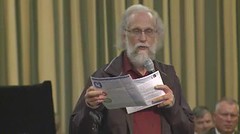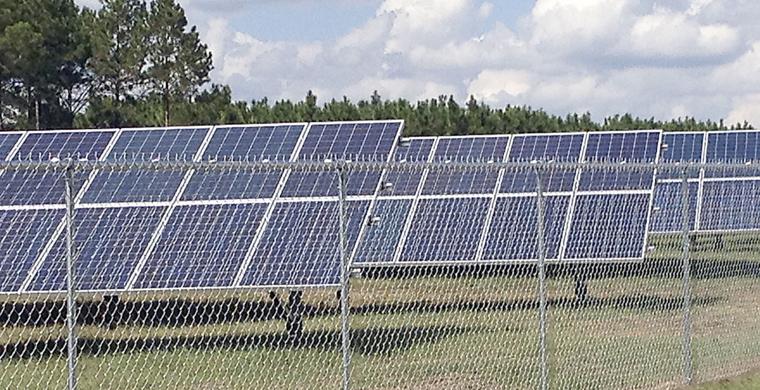Solar power made much of SO’s increased energy revenues for 2013 and 2014. What else will we learn at the Southern Company 2015 Annual Meeting of Shareholders, Wednesday, May 27, 2015? Has Southern Company finally looked up, and will it say, like Thomas Alva Edison in 1931, “I’d put my money on the sun and solar energy”?
To attend the SO shareholder meeting you have to have owned stock by Monday, March 30, 2015, or you’ll need to get somebody to appoint you their proxy. Since I’m an SO stockholder, I got the 216-page Southern Company Notice of 2015 Annual Meeting of Stockholders, Proxy Statement and 2014 Annual Report, page D-8:
In 2014, wholesale revenues increased $329 million, or 17.7%, as compared to the prior year due to a $326 million increase in energy revenues and a $3 million increase in capacity revenues. The increase in energy revenues was primarily related to increased revenue under existing contracts as well as new solar PPAs and requirements contracts primarily at Southern Power, increased demand resulting from colder weather in the first quarter 2014 as compared to the corresponding period in 2013, and an increase in the average cost of natural gas. The increase in capacity revenues was primarily due to wholesale base rate increases at Mississippi Power, partially offset by a decrease in capacity revenues primarily due to lower customer demand and the expiration of certain requirements contracts at Southern Power.
Solar is specifically called out for 2014 as a source of revenue increase. So is natural gas, but only because of a cost increase, and the cost of natural gas has plummetted since then, so it won’t be a revenue increase into 2015, while solar PPAs keep growing.
In 2013, wholesale revenues increased $180 million, or 10.7%, as compared to the prior year due to a $108 million increase in energy revenues and a $72 million increase in capacity revenues. The increase in energy revenues was primarily related to an increase in the average price of energy and new solar contracts served by Southern Power’s Plants Campo Verde and Spectrum, which began in 2013, partially offset by a decrease in volume related to milder weather as compared to the prior year. The increase in capacity revenues was primarily due to a new PPA served by Southern Power’s Plant Nacogdoches, which began in June 2012, and an increase in capacity revenues under existing PPAs.
For 2013, two solar plants in other states are called out. Spectrum is a 30 MW plant in Clark County, Nevada, while Campo Verde is a 139 MW plant in Imperial County, California. Both are joint projects of Southern Power and Turner Renewable Energy.
Sure, they also mention 100 MW biomass Plant Nacogdoches, but it’s the only biomass plant SO has bought, and SO customer Austin Energy already soon got buyer’s remorse about that one.
Meanwhile SO kept up its far-away buying spree with Ted Turner, including (dates are announcement dates):
- 20 MW at Adobe Solar 21 April 2014 in Kern County, CA, to be built by SunEdison.
- 50 MW at Macho Springs Solar 23 May 2014 in Luna County, New Mexico, to be built by First Solar.
- 150 MW at Solar Gen 2 in Imperial County, California, to be built by First Solar.
This is all according to SO’s own Solar Energy News web page, and those acquisitions are also detailed in the 2014 Annual Report.
But the web page shows a marked change in the most recent announced projects: they’re in Georgia!
- 131 MW at in Taylor County, Georgia 17 December 2014, to be built by First Solar and sold under 25-year purchase power agreements with Cobb EMC (101 MW), Flint EMC (15 MW), and Sawnee EMC (15 MW).
- 80 MW at Decatur Parkway Solar Project 20 February 2015 in Decatur County, Georgia,
- 19 MW at Decatur County Solar Project 20 February 2015, in Decatur County, Georgia,
Also note none of those Georgia projects are in conjunction with Ted Turner. SO has finally taken off the training wheels and has ridden back home to Georgia.
 I wish I’d thought of that, maybe like
two years ago at the
2013 SO Stockholder Meeting
where I read from the
Campo Verde flyer
and the
longer press release
and noted:
I wish I’d thought of that, maybe like
two years ago at the
2013 SO Stockholder Meeting
where I read from the
Campo Verde flyer
and the
longer press release
and noted:
I’m talking about building the economy, 239 million over the next 30 years to the local county, $17.5 million in local tax revenue, 250 construction jobs. Unfortunately, that’s in California.
However, we can have that right here in the Southeast, which is where I want to compliment Paul Bowers at Georgia Power because Georgia Power is helping connect two megawatts of solar power coming into Valdosta, Georgia, in the near future and perhaps some more.
 And the City of Valdosta’s added to its 0.3 MW Wiregrass Solar Plant
another
1.25 MW at its Mud Creek Solar Plant,
which presumably figured into that
“increase in capacity revenues under existing PPAs”.
Those two solar projects were the
first two items listed for Valdosta’s award as
Smart Energy Municipality of the Year.
And the City of Valdosta’s added to its 0.3 MW Wiregrass Solar Plant
another
1.25 MW at its Mud Creek Solar Plant,
which presumably figured into that
“increase in capacity revenues under existing PPAs”.
Those two solar projects were the
first two items listed for Valdosta’s award as
Smart Energy Municipality of the Year.
That same SO Solar Energy News web page also mentions as “Other Solar Projects”:
- Georgia Power plans to build, own and operate three separate 30-MW solar generation facilities on U.S. Army bases in Georgia.
In addition to those three 30 MW military projects, Georgia Power also did 30 MW at Kings Bay Submarine Base.
- Georgia Power selling 700kW of solar to Dalton Utilities under power purchase agreement (PPA).
- Georgia Power procuring more than 800 MW from new solar generation in Georgia developed as part of Large Scale Solar (LSS) and Advanced Solar Initiative (ASI) programs.
SO didn’t mention that last is because activists across Georgia persuaded GA PSC in July 2013 to require an additional 525 MW of solar power.
Also in that SO Solar Energy News web page:
Other Electric Revenues
Other electric revenues increased $33 million, or 5.2%, and $23 million, or 3.7%, in 2014 and 2013, respectively, as compared to the prior years. The 2014 increase was primarily due to increases in open access transmission tariff revenues and transmission service revenues primarily at Alabama Power and Georgia Power, an increase in co-generation steam revenues at Alabama Power, increases in outdoor lighting and solar application fee revenues at Georgia Power, as well as an increase in franchise fees at Gulf Power. The 2013 increase in other electric revenues was primarily a result of increases in transmission revenues related to the open access transmission tariff and rents from electric property related to pole attachments.
There’s solar again. Other than that, it’s mostly “increases in open access transmission tariff revenues”. Translation: Georgia Power got GA PSC to increase its guaranteed profit again.
And notice what’s not mentioned as a source of new revenue: Plant Vogtle, where for two years Georgia Power couldn’t even get a schedule from its own contractors, after it’s already about a billion dollars overbudget.
While solar projects go in on budget, on time, with reliable power production and revenue generation, plus no fuel costs, no pipelines, and no emissions.
Maybe Southern Company will look at its own revenue records in its own report and decide that fixing climate change is profitable? If solar growth like compound interest has turned even Al Gore into an optimist, why not SO?
Southern Company and Georgia Power and all the EMCs and MEAs did agree on solar financing bill HB 57, which unanimously passed the Georgia House and Senate. They did require limits on commercial distributed solar generation. But maybe that’s because our utilities are finally realizing solar is where their profit is, not just now, but far more so in the near future.
HB 57 was sent to Gov. Nathan Deal 6 April 2015. Sure, he took campaign contributions from multiple fossil fuel companies. But will even he refuse to sign a bill passed unanimously by both houses of the legislature, with overwhelming public support, and backed by all the utilities? The backlash might be very interesting in the next election if he did.
I suspect the clammy hand of the fossil fuel industry won’t be able to stop HB 57. And when it’s law, Georgia Power and Southern Company will likely move ahead even faster on solar power, adding to their bottom lines. That’s something shareholders like.
-jsq
Short Link:
